Hugh Glass dragged himself over 200 miles to the nearest fort after being mauled by a grizzly bear and left for dead by his fellow fur trappers. Then, he began his quest for revenge.
The two men who had been ordered to watch over Hugh Glass knew it was hopeless. After single-handedly fighting off a grizzly bear attack, no one had expected the fur trader to last five minutes — let alone five days. But there he was, lying on the banks of the Grand River, still breathing.
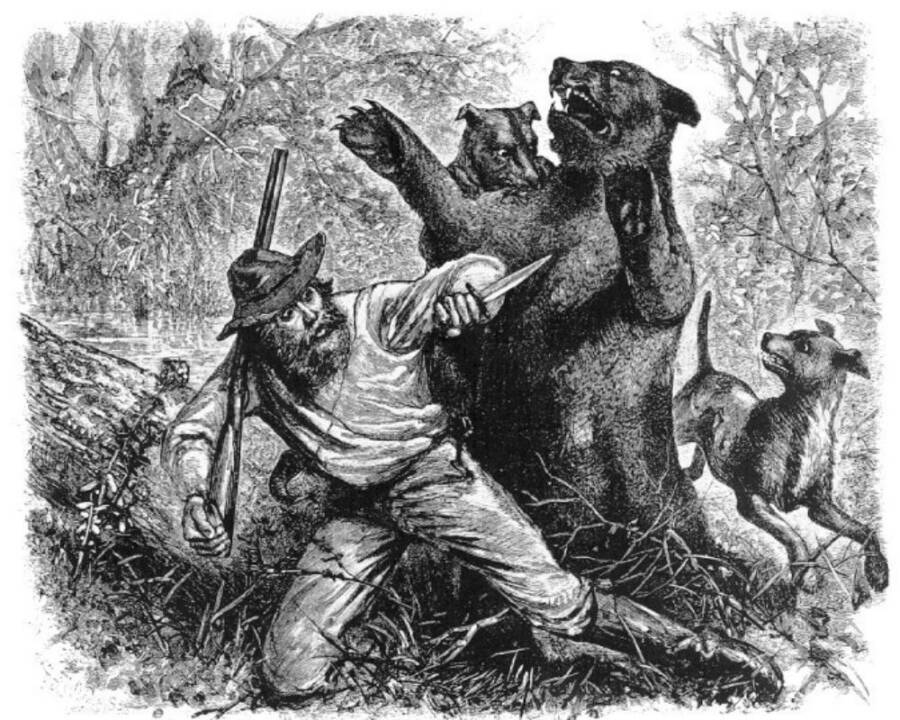
Wikimedia CommonsA newspaper illustration of Hugh Glass fighting off the grizzly bear that attacked him.
Aside from the rise and fall of his chest with each labored breath, the only sign of life from Glass was the occasional movement of his eyes. He would look around every so often, though there was no way for the other men to know if he recognized them or if he needed something.
As he lay there dying, the men became increasingly paranoid, knowing they were encroaching on the land of the Arikara tribe. They didn’t want to risk their lives for someone who was slowly losing his.
Finally, fearing for their safety, the men left Hugh Glass to die, taking his gun, knife, tomahawk, and fire-making kit with them — after all, a dead man needs no tools.
Of course, Hugh Glass wasn’t dead yet. And he wouldn’t be for quite some time.
Pirates And Pawnees: The Early Life Of Hugh Glass
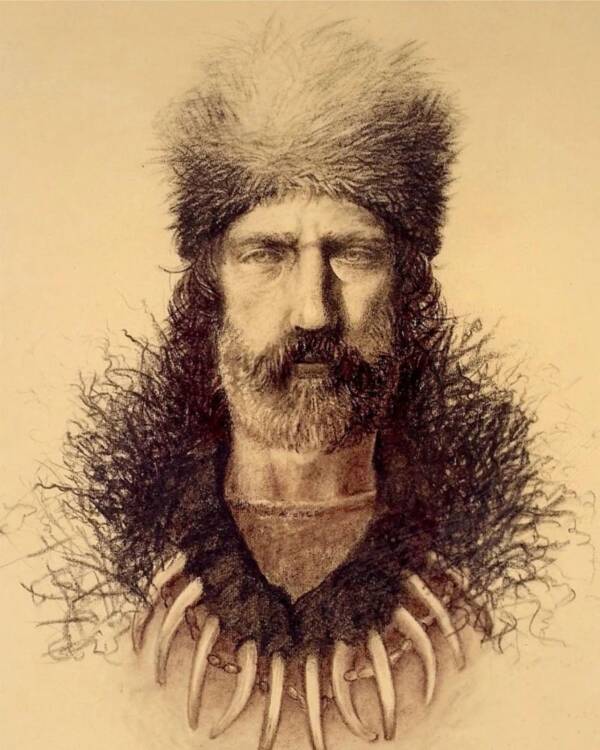
Public DomainA sketch of Hugh Glass from c. 1830.
Long before he was left for dead on the banks of the Grand River, Hugh Glass was a force to be reckoned with. According to the Museum of the Mountain Man, he was likely born to Irish immigrant parents in Pennsylvania around 1783. Little is known about his early life, but according to those who knew him, he was working as a sailor by 1817.
The memoirs of George C. Yount, a fellow fur trader who worked alongside Hugh Glass, are believed to be credible. Per Yount, Glass claimed that a ship he was on was seized by the infamous pirate Jean Lafitte around 1820. Glass was given the choice to join Lafitte or die — and he chose a pirate’s life.
He reportedly served under Lafitte for a year or two before escaping to the shores of what is now Galveston, Texas. Once there, Glass was captured by the Pawnee tribe, with whom he lived for several years. Some tales about his life even claim that he married a Pawnee woman.
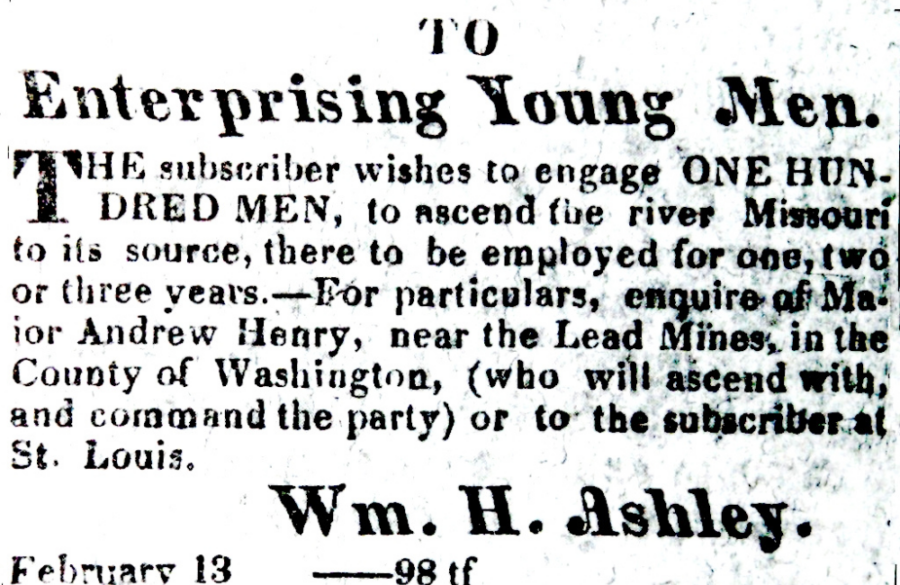
Wikimedia CommonsThe newspaper advertisement that led to Hugh Glass joining “Ashley’s Hundred.”
Then, in 1822, Glass learned of a fur-trading venture. Per the South Dakota Office of Tourism, a newspaper advertisement placed by General William Henry Ashley called for 100 men to “ascend the river Missouri” to explore uncharted lands and trap animals for their fur. Glass eagerly signed up to become one of “Ashley’s Hundred” — a decision that would cement his name in history.
Inside The Grizzly Bear Attack That Inspired ‘The Revenant’
Throughout 1822 and 1823, Ashley’s Hundred trekked up the Missouri River, hunting and trading furs as they went. Along the way, they had a violent encounter with members of the Arikara tribe. Several of the traders were killed, including a man named John Gardiner. Glass wrote a letter to Gardiner’s family to share the sad news:
My painfull duty it is to tell you of the deth of yr son wh befell at the hands of the indians 2d June in the early morning… We traded with them as friends but after great storm of rain and thunder they came at us before light and many were hurt. I myself was shot in the leg. Master Ashley is bound to stay in these parts till the traitors are rightly punished.
Just a few months later, in August 1823, Glass had his infamous run-in with a grizzly bear. While hunting with a group of about 15 other men, Glass accidentally surprised the bear and her two cubs. The creature charged, knocking Glass to the ground and mauling him.
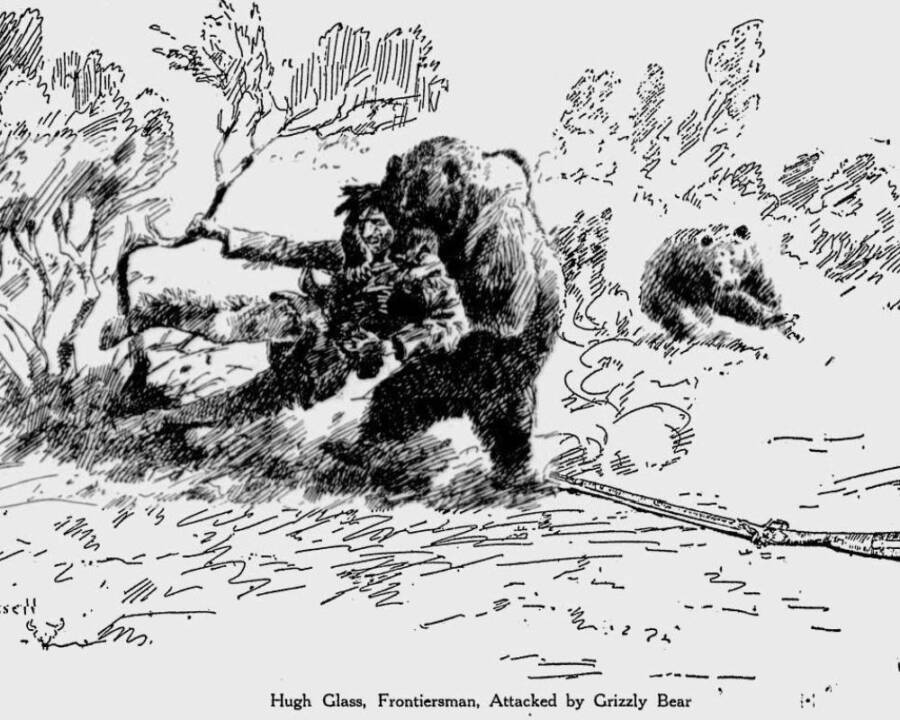
Wikimedia CommonsAn illustration of Hugh Glass being mauled by a grizzly bear from a 1922 newspaper.
Some versions of the story state that Hugh Glass fought the bear off on his own, while others tell of his fellow trappers coming to his rescue. Either way, Glass barely survived the ordeal. His injuries reportedly included a broken leg, a ripped scalp, a punctured throat, and deep gashes on his back that exposed his ribs.
Nobody in the party believed that Glass would live for more than a few hours, yet they strapped him to a makeshift gurney and carried him along with them anyway. The critically injured man surprised them all by surviving through the night and the following day.
Soon, however, they realized that the added weight was slowing them down — in an area that they very much wanted to get through as quickly as possible.
They were still in Arikara territory, and they wanted to reach their destination swiftly to avoid another attack. According to Encyclopedia Britannica, the group still anticipated that Glass would die soon, so they decided to leave two men behind with him who would catch up after burying his body.

Wikimedia CommonsAn Arikara man wearing the skin of a bear. 1908.
These two men were John Fitzgerald and a teenager named “Bridges,” who some historians believe was actually famous mountain man Jim Bridger. However, when Glass was still clinging to life five days later, they decided to abandon him. They took his weapons and tools, leaving him helpless in the wilderness.
But Glass managed to survive — and he made it his life’s mission to seek revenge on the men who had left him to die.
Hugh Glass’ Ultimate Quest For Revenge
When Glass regained consciousness, he quickly realized he’d been abandoned. Based on his knowledge of his surroundings, he believed he was about 200 miles from Fort Kiowa, where he would be able to get help.
Crawling at first, then slowly beginning to walk, Hugh Glass made his way toward the fort. He ate what he could find. This mostly consisted of berries, roots, and insects, but occasionally he came across the remains of buffalo carcasses that had been ravaged by wolves.
Roughly halfway to his destination, he ran into a tribe of Lakota, who were friendly toward the fur traders. There, he managed to bargain his way into a skin boat.

Alfred Jacob Miller/Wikimedia CommonsFur traders often made peace with local Native Americans, though they frequently battled with some tribes, such as the Arikara.
He reached Fort Kiowa around six weeks after the bear attack. Once he had rested and purchased supplies on credit, Glass set out once more to rejoin Ashley’s Hundred. When he eventually caught up with them, everyone was shocked to see him alive. Fitzgerald had left the group to join the U.S. Army, but Bridges was still with them. It was time for Glass to act on his desire for revenge.
However, when Glass confronted Bridges, he supposedly forgave the teenager. He realized that it was Fitzgerald who had convinced the boy to leave him behind.
Glass then set out to find Fitzgerald — and forgave him as well. Fitzgerald was protected by the Army, so Glass couldn’t harm him without facing punishment himself. Fitzgerald was reportedly forced to return Glass’ shotgun, though.
His mission to track down Bridges and Fitzgerald complete, Glass continued working as as fur trader for the next 10 years. He escaped two more violent run-ins with Native Americans and even another stint alone in the wilderness after he became separated from his trapping party during an attack.
In 1833, however, Glass finally met the end he’d been evading for so long. According to the National Park Service, while on a trip along the Yellowstone River with two fellow trappers, Hugh Glass found himself under attack by the Arikara once again. This time, he was not so lucky.
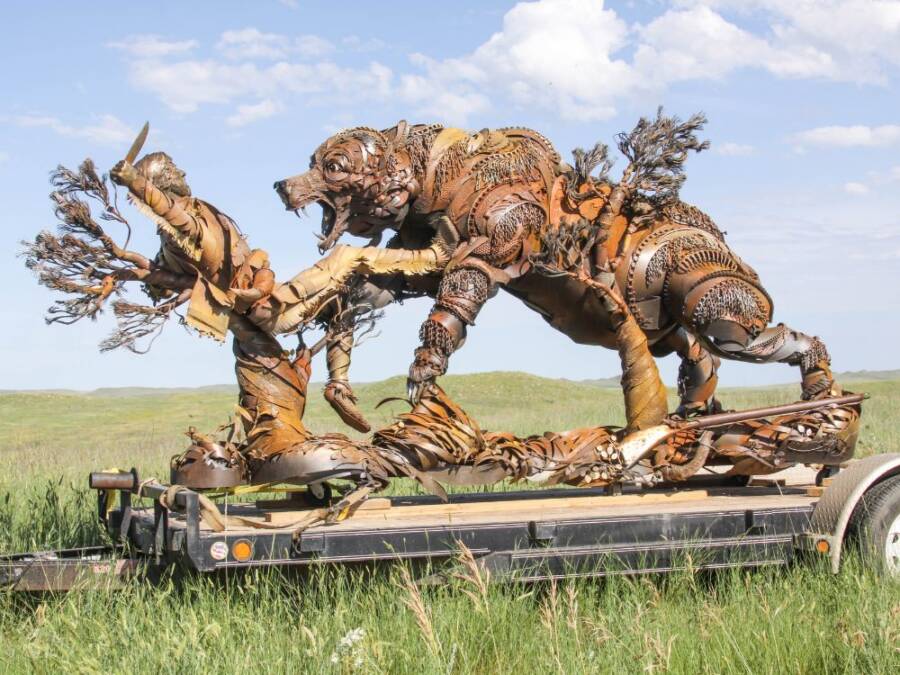
Wikimedia CommonsA memorial sculpture to Hugh Glass is erected in Lemmon, South Dakota, where he was attacked by the bear.
Glass’ epic tale was so incredible that it caught the eye of Hollywood and was transformed into the Oscar-winning film The Revenant starring Leonardo DiCaprio. Today, a monument stands along the southern shore of the Grand River near the site of Glass’ famous attack, reminding all who pass of the man who took on a grizzly bear and lived to tell the tale.
After reading about Hugh Glass and the real story behind The Revenant, check out the life of Peter Freuchen, another bear-wrestling badass. Then, read about the Montana man who was attacked by a grizzly bear twice in one day.





